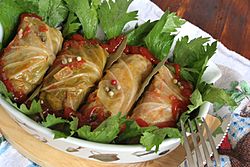Holishkes facts for kids
Holishkes (also called holipches or huluptzes) is a traditional Jewish dish. It's a type of cabbage roll made by wrapping blanched (lightly boiled) cabbage leaves around a filling. The main filling is usually minced meat, and sometimes rice is added too. These rolls are then cooked slowly in a tasty tomato sauce.
Holishkes are eaten all year, but they are especially popular during certain Jewish holidays. On Sukkot, they symbolize a good harvest. On Simchat Torah, two stuffed cabbage rolls placed side by side look like Torah scrolls, which are important holy books.
The Story of Holishkes
Holishkes didn't start as a Jewish dish. Jewish communities in Eastern Europe, like those in the Russian Empire and Poland, learned how to make this dish from their Slavic neighbors. Similarly, Jews in Hungary and the Balkans learned it from their Slavic and Romanian neighbors. A similar dish in those regions is called sarma.
Eastern European Jews sometimes called this dish "golub," which means "dove." This was because the rolled cabbage in sauce looked a bit like a bird sitting in a nest.
The way Holishkes are spiced can be different depending on where the Jewish community came from:
- Hungarian Jews often add a little marjoram.
- Syrians might include cinnamon.
- Persians sometimes add dill and mint.
In the past, meat was quite expensive. To make the dish more affordable and stretch the meat further, cooks often added rice to the filling. This made the meal more filling without needing as much meat.
See also
 In Spanish: Holishkes para niños
In Spanish: Holishkes para niños


